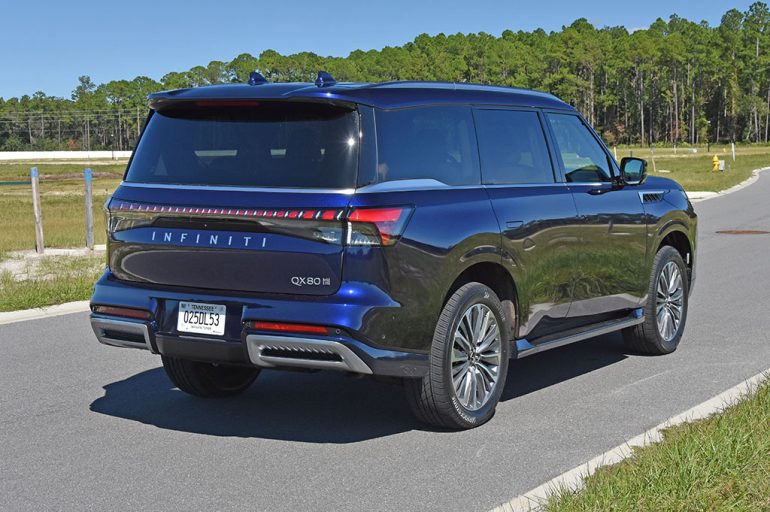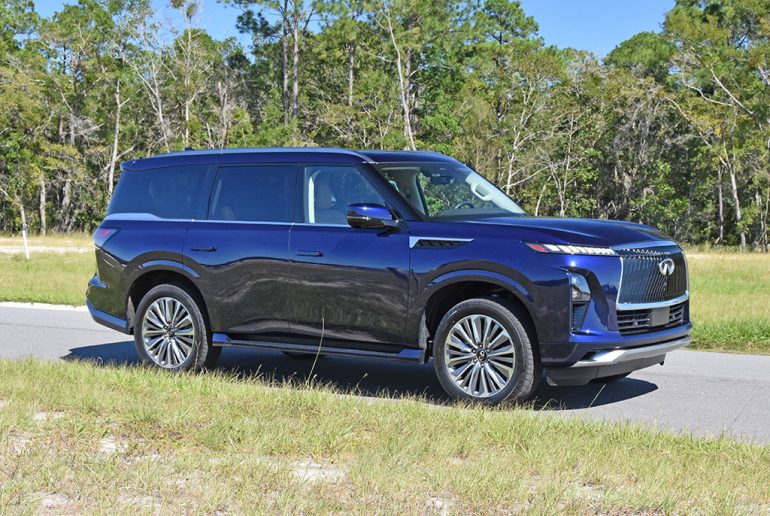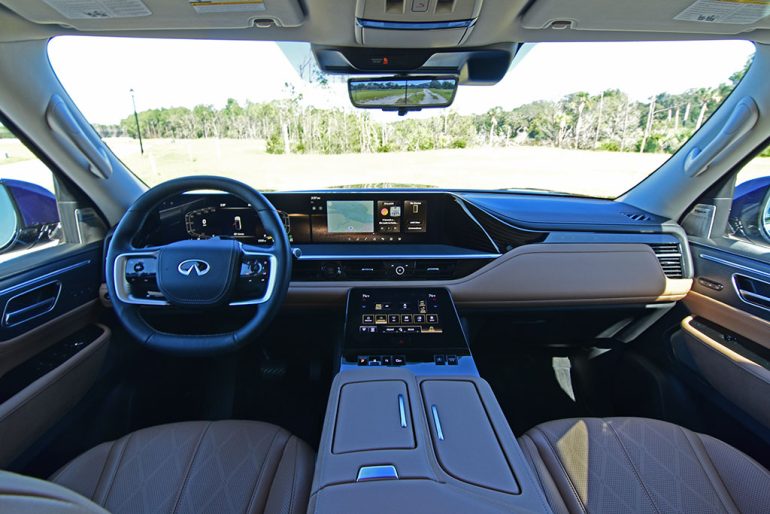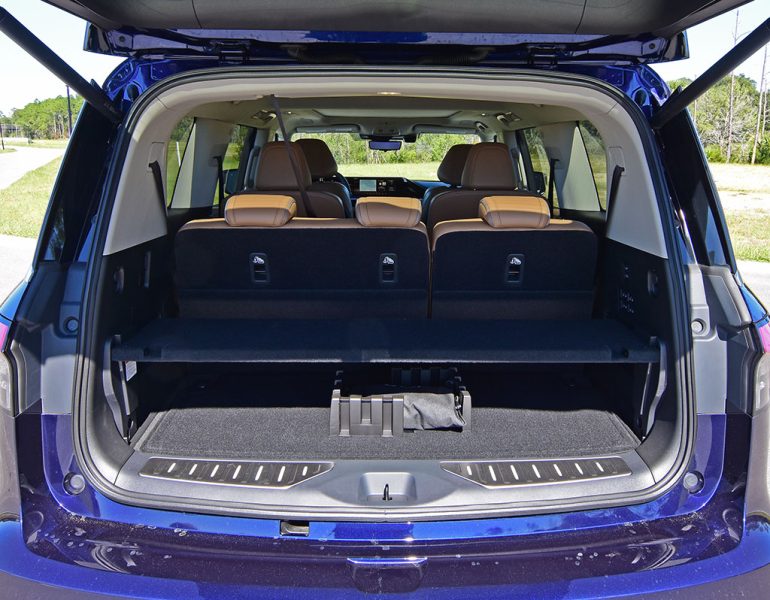
The Infiniti QX80 has been a long-standing body-on-frame luxury SUV that serves as a respected alternative for those looking for large luxury at a decent price. After about 14 years of polishing the second generation of the QX80, Infiniti has finally redesigned the mammoth-size SUV, ushering in just what it needed to compete on a broad spectrum against the likings of the Cadillac Escalade, Lincoln Navigator, and other large luxury SUVs.
Embarking on a newfound journey, the newly redesigned QX80 receives the proper treatment in making it a luxurious contender without compromise inside and out, even with a new powertrain that departs from the tried-and-true V8 that seemingly had poor fuel consumption no matter how you drove the large SUV. Much of what the new Infiniti QX80 receives is all for the better receiving much of what we saw in the QX Monograph Concept, improved in just about every way, with more of a soft and luxurious theme to the new vehicle that shines brighter than it has ever for the brand.
Also, don’t forget that you can get discounted new car pricing with a free quote through qualified local dealer partners.

The Infiniti QX80 enjoyed its entirety being powered by a V8 engine, first as the QX56 and then nearly a decade and a half for the second-generation, having 400 horsepower and 413 lb-ft of torque as its beckon. Now, in comes a new 3.5-liter turbocharged V6 engine that touts 450 horsepower and 516 lb-ft of torque mated to a 9-speed automatic transmission, a substantial power increase over the outgoing model. That power feels strong and adequate for the new QX80 all through the powerband. There isn’t much noticeable turbo lag out of the hole, and the engine is eager to move the often heavy-feeling QX80 with some urgency.

Zero to 60 mph ticks off in just 6 seconds for the AWD QX80, which is another surprising aspect of the new QX80 as its turbocharged V6 engine seems to perform quite well as it runs to redline, and the 9-speed automatic transmission does well to fire off quick but smooth shifts. Rear wheel drive can be had in the base Pure trim or Luxe trim while the Sensory and Autograph trims get standard all-wheel-drive.
Piloting the new QX80 feels marginally easier than the outgoing model, which may be attributed to better overall dynamics in the suspension system, which is a dynamic air system. The ride quality is somewhat rough at lower speeds but seems to magically smooth out at highway and interstate speeds, where the system will automatically lower the vehicle at such speeds for better aerodynamics and stability. 22-inch wheels remain but with a new style for three upper trim levels out of a total of four available trims (Pure, Luxe, Sensory, Autograph). The drive modes didn’t seem to change the ride quality much, only adding steering effort and remapping throttle input.

The air suspension is interesting as it tends to take a long time to lower to an automatic, easy entry height. There is a method of manually lowering the vehicle for easy entry/exit or raising it to its off-road height. Overall, the ride quality is improved and feels surprisingly smooth at higher speeds versus back roads, where imperfections are often transmitted throughout the cabin but with some composed control to never feel lofty or overly bouncy. The good control of the QX80 gives you confidence as a driver in navigating such a large and in-charge vehicle. That control more than likely translates into doing a decent job in towing, which the new QX80 AWD can tow up to 8,500 pounds.
Having the new turbocharged V6 gives the QX80 a slightly new lifeline for being more efficient, considering the significant power increase. While on paper, the EPA estimates don’t necessarily show the full ‘improved’ picture, you will be able to match the estimates of 15 mpg city, 19 mpg highway, and 17 mpg combined. In fact, I was able to get slightly better fuel mileage in the city and highway, getting nearly 17.3 mpg and 20.5 mpg, respectively. As a quick reminder, the outgoing QX80 was never able to get its EPA estimates in the real world from my many tests, always leaving me disappointed and at the gas station filling up often. This time, the new QX80 proved to be more consistent with its fuel economy and was able to get a lot closer to the estimated range of 448 miles thanks to a large 23.59-gallon fuel tank full of premium unleaded.

The newly redesigned QX80 turns everything up a few notches for a new position in the luxury spectrum that features a cleverly reworked cabin. Throughout, there’s an abundance of soft-touch surfaces, leather-wrapped areas with accented stitching, and subtle trim accents. In my QX80 Sensory trim test vehicle, the interior was plush but with somewhat of a soft approach instead of in-your-face contrasts. Such vibrant contrasts seem to be more reserved for the top-level Autograph trim. However, there’s a lot to appreciate in the luxury theme of the new QX80, regardless, which starts with the heated, ventilated, and massaging front seats now with a good amount of adjustability for better positioning for people who are over 6 feet tall, like me. The outgoing QX80 always felt constrained by limited front seat aft adjustment, in my opinion. All of that is fixed now as you can bring up additional seat controls through the new large 14.3-inch touchscreen display.

The new screens, which combine two 14.3-inch screens, one for the digital driver’s gauge cluster and the other flanked in the same enclosure as the main touchscreen, is a welcomed departure from anything that Infiniti has had, which is a good thing. The system also combines a lower 9-inch touchscreen with haptic feedback that serves as the controls for the tri-zone automatic climate control system, which features biometric cooling using an infrared sensor in the headliner to detect a passenger getting warm and then redirecting cool air to that person. The lower screen, which often suffered from a slight hiccup of delaying the haptic feedback upon depressing onscreen buttons, also integrates drive controls for drive modes and air suspension toggle. There’s a physical air suspension button for enabling automatic control and a dedicated camera button – all next to a set a transmission selector buttons.

The seating areas in the second row, featuring heated and ventilated captain’s chairs, are power-adjustable and perform a quick power-moving function for easy access to the third row, which is surprisingly accommodating once you lift the rather large headrests. Speaking of headrests, Infiniti takes things up a level for the new Klipsch audio system featuring 28 speakers with ones integrated into the front headrests. The system sounds good but seems to need just a bit more power when playing complicated and layered songs. The headrest speakers are clever as the driver’s headrest speakers will be the only ones to fire sound for navigation or announcements from the new Google-based system. Such sound also includes navigation announcements from apps on your smartphone, which is allowed via wireless (or USB-connected) Apple CarPlay and Android Auto integration. A wireless charging pad is located under the left armrest door, which often gets in the way when it’s opened as the door protrudes out of the cubby area. There’s nicely placed LED ambient lighting throughout with special touches of the illuminated Infiniti lettering on the dash, accented LED lighting along the edges of the panoramic sunroof’s power shade, and clever exterior lighting elements such as a lighted Infiniti emblem.

Infiniti was once known to push some technological boundaries, being one of the first to introduce new advancements, such as a 360-degree surround-view camera system and a creative lane departure mitigation system. Now, Infiniti keeps on pace with the rest in bringing advancements like the latest ProPilot Assist 2.1 system, which is Infiniti’s version of a hands-free driving system via pre-mapped roads comparable to GM’s SuperCruise and Ford’s BlueCruise. In testing the system, it worked well on one local highway and Interstate 95 here in Florida. Overall, the system seemed to keep well within the lanes and always displayed the proper status of what the system was detecting on the road, from the type of lane markings to the neighboring vehicle types, all in the digital gauge cluster. The color head-up display would mimic some of the system’s status, clearly displaying when you can allow the system to drive hands-free. The system would abruptly alert you to take control or face forward through the gauge cluster and head-up display. The lane change function was somewhat confusing at first, and would often ask for you to take control of most of my lane change attempts after a confirmation press of the steering wheel lane change button.

Apart from the new ProPilot Assist feature, the Infiniti QX80 combines all of the other typical active safety features (lane departure/keep assist, forward collision warning/emergency braking, rear cross-path detection/rear emergency braking, pedestrian detection, blind-spot monitor/mitigation, adaptive cruise control) in addition to having a front and rear dash cam system.

Just like everything else and most new cars, pricing has increased for the newly redesigned QX80. However, here, a price increase is fairly justified in how much the QX80 has improved to have a better standing amongst its competition, which, in my opinion, it does very well and comes down to preference at this point. The new Infiniti QX80 now starts at $85,580 before any fees or options but can quickly top $100K when you opt for the trim level of my QX80 Sensory test vehicle ($99,950 before options and fees), which tests out at $108,095 nicely equipped with several options (ProPilot Assist 2.1++ Package, Interior Lighting Package, Premium Cargo Package, Premium Paint, and Umbrella holder), including a $1,995 destination charge.